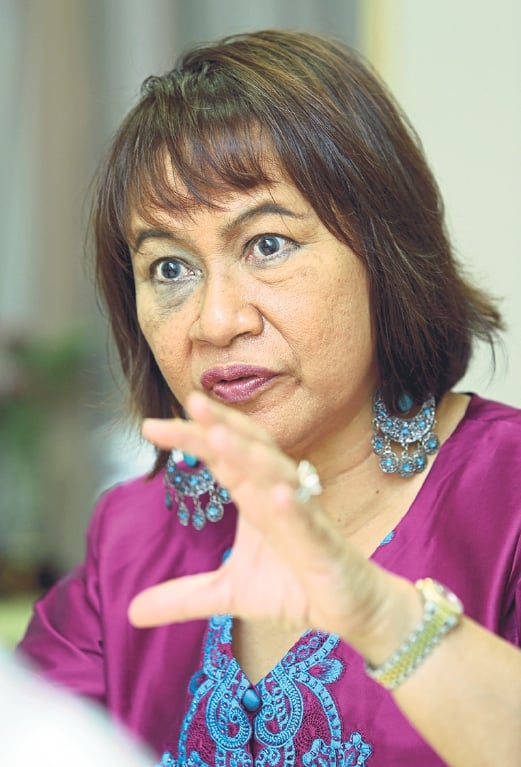Don’t ignore abnormal menstrual bleeding as it may indicate the presence of uterine fibroids, writes Meera Murugesan
EXCESSIVE bleeding and pain are not things we would ordinarily ignore. Yet, when those same symptoms are linked to menstruation, many women assume it’s normal and endure.
Problems such as heavy, long and painful periods, bleeding in between periods, pain in the abdomen or lower back and feeling of pelvic pressure shouldn’t be ignored because they may indicate the presence of uterine fibroids.
Symptomatic fibroids can considerably impact a woman’s sexual life, work performance and her relationships with friends and family.
The condition can disrupt daily life for women and make even little things challenging.
COMPLEX PROBLEM
When the fibroid is small, women do not experience any symptoms, so they think there’s no problem, says Dr Jamiyah Hassan, senior consultant obstetrician, gynaecologist and feto-maternal specialist at University Malaya Medical Centre (UMMC).
Uterine fibroids or myomas as they are medically referred to, can be anything from 0.5cm in size to as large as the uterus of a 28-week pregnant woman.
A woman may have just one fibroid or many of varying sizes, located in different areas of the uterus.
“The uterus has muscles called smooth muscles. A myoma is actually the abnormal growth of the smooth muscles of the uterus,” explains Dr Jamiyah.
How and why it happens remains a mystery. Age and ethnicity however, do play a role. Older women are more at risk and women of African descent also have an increased risk.
The condition is not so common among Asians but among African women, even young girls, may develop multiple fibroids.
Many epidemiologic factors such as consumption of alcohol, smoking, obesity and even stress have also been linked to the development of myomas but these are not yet fully understood.
Dr Jamiyah says that not every obese woman develops fibroids and not all highly stressed women have the condition either.
“How it starts we don’t know but once it starts, it’s hormone driven. Oestrogen and progesterone increase its growth,” says Dr Jamiyah who adds that it occurs in about 50-60 per cent of women of reproductive age who are more than 35.
Often, it is not detected clinically until women seek treatment because of the symptoms. Once the fibroids get bigger and cause pain and bleeding, women seek treatment and an examination may reveal the condition.
The best way to diagnose the condition is through ultrasound as it enables doctors to see the fibroid clearly, even if it’s very small, count the number of fibroids and identify its location.
Dr Jamiyah says women who suffer from the symptoms for long without seeking treatment may end up anaemic because they are bleeding excessively every month.
These women will eventually go to hospital complaining of lethargy and excessive menstrual blood loss. Abnormal bleeding remains the main complication that most women face. In an eight year study conducted by UMMC from 2000-2008, 60 per cent of patients diagnosed with the condition first came to the hospital complaining of excessive bleeding during their periods.
Pregnant women with the condition will find that their fibroid grows in size as a lot of hormones are being supplied to the body during pregnancy.
Dr Jamiyah says the condition can also affect the pregnancy if the myoma is located at the bottom of the uterus. As the foetus gets bigger, it cannot align itself and when it’s time for delivery, the baby is unable to descend.
If the myoma sits on more than half the size of the placenta, it may also affect placental growth during pregnancy. The condition may also result in sub-fertility among some women.
TREATMENT
Traditionally, treatment for the condition has been surgical. Dr Jamiyah says if a woman has completed her family, the most conclusive or definitive treatment is to remove the uterus. But this is not an option for women who still want to get pregnant.
Doctors can also perform a myomectomy, where they just remove the fibroid or fibroids but leave the uterus intact.
“In a myomectomy, we literally scoop out the fibroids. If you have just one, the risk is smaller but if you have say five, the more we scoop out, the more holes we create, the more we have to stitch and more bleeding will happen.”
Fibroids do not regrow after surgery but new fibroids may develop and more surgery may be needed. Other treatment options include radiological intervention and gonadotropin-releasing hormones (GnRH) agonist injection treatment to shrink the fibroids, both of which also carry risks and side effects.
MEDICATION is an option for some women with uterine fibroids. Ulipristal acetate (UPA) 5mg, which was launched in Malaysia on Sept 20, is the first-in-class oral therapy for uterine fibroids.
It helps to stop uterine bleeding, correct anaemia and shrink fibroid volumes. The prescription-only drug has been shown to be effective in shrinking fibroids volume by 54 per cent after the second course of treatment, providing relief from uterine fibroid associated pain.
It helps patients manage moderate to severe symptoms associated with the condition and enables women to either avoid or delay surgical intervention.








